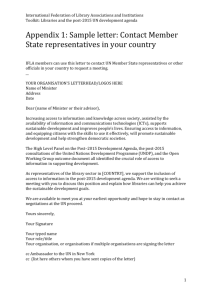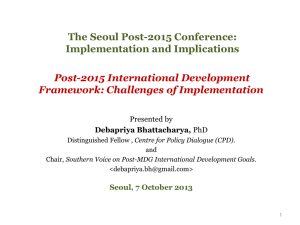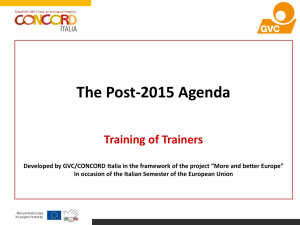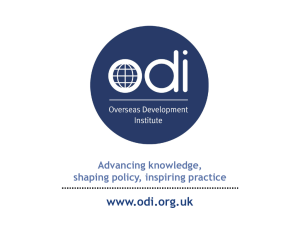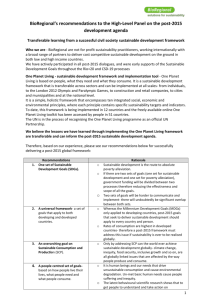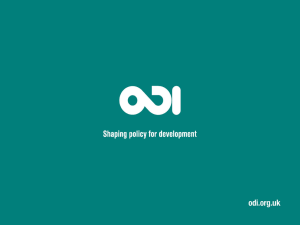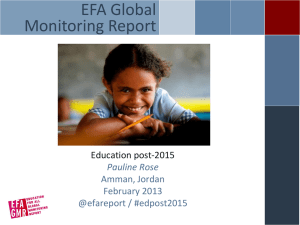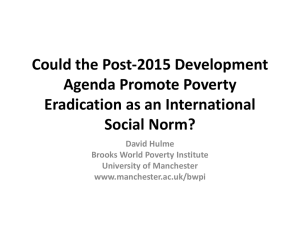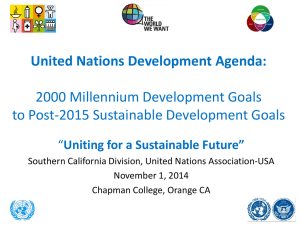Secure Land Rights for Women and Men in the Post
advertisement
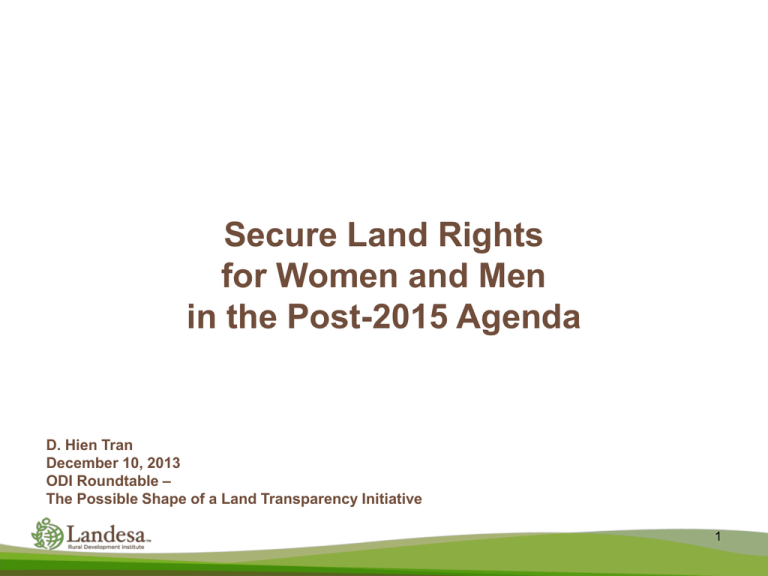
Secure Land Rights for Women and Men in the Post-2015 Agenda D. Hien Tran December 10, 2013 ODI Roundtable – The Possible Shape of a Land Transparency Initiative 1 A Look Back: Millennium Development Goals and Rights to Land and Property Land and property rights effectively not included in the Millennium Development Goals A “missing dimension” of the MDGs – lack of secure rights to land, particular for women, is an obstacle to achieving several MDGs, including: • Eradicating hunger and poverty • Achieving gender equality • Ensuring environmental sustainability 2 Landesa’s Post-2015 Advocacy Inclusion in the post-2015 framework creates an environment of urgency, incentive, and pressure for governments to address land rights for women and men Unique window of opportunity to make the case Post-2015 Advocacy Goal The inclusion of targets and indicators on secure land rights for women and men in the post-2015 framework 3 Post-2015 Recent Developments Outcome Document • Adopted September 25, 2013 • UN member states agree to a roadmap for developing and adopting a post-2015 framework Key Points of Agreement • A single framework and set of goals applicable to all countries, taking into account national circumstances • Process of intergovernmental negotiations to launch at 69th UNGA session in September 2014 • High-level Summit to adopt a new set of goals in September 2015 4 Growing Momentum Post-2015 Report Proposed Goals Proposed Secure Land Rights-Related Targets High-Level Panel End Poverty Increase by x% the share of women and men, communities, and businesses with secure rights to land, property, and other assets Empower girls and women and achieve gender equality Ensure equal right of women to own and inherit property, sign a contract, register a business and open a bank account Sustainable Development Improve agricultural systems Ensure universal access in rural areas to Solutions Network and raise rural prosperity basic resources and infrastructure services (land, water, sanitation, modern energy, transport, mobile and broadband communication, agricultural inputs, and advisory services) UN Global Compact Achieve women and girls’ empowerment Full and equal access of women to ownership, property rights and land titles 5 Growing Momentum Post-2015 Report Secure land and property rights Participate Study “Priority should be given to ensuring basic needs relating to food, sanitation and land rights as without these the poorest cannot access services such as education.” Review of 84 participatory studies based on views of those living in extreme poverty UN Secretary General’s Report Transformative actions needed include: Empower women and girls. Among other things, women and girls must have “the right to own land and other assets.” Open Working Group Interim Report “[A] lasting solution to the scourges of poverty and hunger must include raising smallholder productivity and rural incomes on a sustainable basis. This will require greater investments in agricultural research and rural infrastructure, as well as measures to provide more secure access to land, credit, crop insurance and other productive inputs to smallholder farmers, especially women farmers. 6 Land and Governance in Post-2015 • Governance discussion has been broader and not focused on land governance or any other area specifically. • Discussion has focused on broader issues and concepts of : • rule of law accountability transparency freedom of speech and media access to justice open political choice High-Level Panel Report Goal 10: Ensure good governance and effective institutions – Provide free and universal legal identity, such as birth registrations – Ensure that people enjoy freedom of speech, association, peaceful protest and access to independent media and information – Increase public participation in political processes and civic engagement at all levels – Guarantee the public’s right to information and access to government data – Reduce bribery and corruption and ensure officials can be held accountable 7 Land and Governance in Post-2015 • There has been some discussion of land rights in the context of the rule of law, access to justice, and legal empowerment. • UN Technical Support Team Issues Brief: Conflict Prevention, Postconflict Peacebuilding and the Promotion of Durable Peace, Rule of Law and Governance: “It is now widely recognized that improved security of tenure for land and property is critical to ensure social and economic progress across rural and urban settings and that the rule of law facilitates the protection of land, property and other resource rights.” • But the discussion on land rights focuses more on their role in helping to achieve goals related to poverty reduction, gender equality, food security, and environmental sustainability. 8 Key Takeaways on “Why” Land/Property Rights in Post-2015 Framework Broad array of actors recognize that . . . Secure rights to land and property for women and men should be explicitly included in the post-2015 agenda Targets are included under several goals The cross-cutting nature of land and property rights for women and men represents a substantial opportunity: Efforts to strengthen and enforce them can help achieve multiple goals in a post-2015 agenda. 9 Now – What should this look like? Governments are still engaged in consultation process and seeking proposals for what targets and indicators could be used to show progress toward particular goals Meaningful Measurable Simple 10 Targets: Accuracy, Inclusiveness, Clarity Range of rights • E.g., to sell, use, inherit, rather than ownership alone. Need to reflect different contexts. Secure rights • Clearly defined, long-term, enforceable, appropriately transferable, and legally and socially legitimate. For women, should not require consultation or approval beyond that required of men. Access to secure rights • i.e., access to the system that confers, administers, supports, and enforces secure rights to land and property. Women and men • Critical to call out women explicitly, otherwise potential exclusion when refer to households alone. Land rights • Rather than “tenure security” for accessibility. 11 Indicators: Guiding Principles Reflect outcomes rather than inputs Address several factors needed to achieve target Measure what is critical, even if greater data collection required Sex-disaggregated – women should be called out specifically Limited in number Relatively simple 12 Possible Outcome-Focused Indicators in Post-2015 Context Documentation: Percentage of women and men with documented rights to land • Reflects several elements: policy environment, institutional support and effectiveness, ability to obtain documents • Document can reflect local context; should not be limited to ownership documents • Can include documentation to community lands • Do not need exhaustive list of documents but have criteria for what constitutes valid document Perception: Percentage of women and men who do not fear arbitrary dispossession of land • Proxy for people’s perception of tenure security • Investment in land decisions shaped by perception • Can reflect security experienced as individual, household, and community • Can capture range of forced tenure changes 13 Thank you. 14
